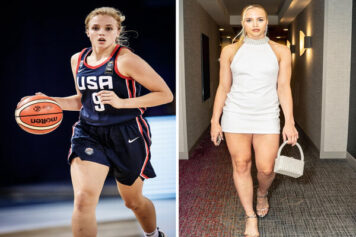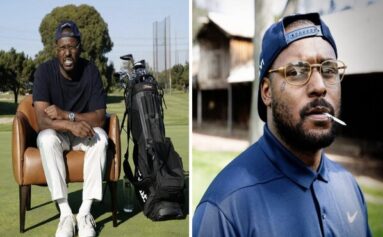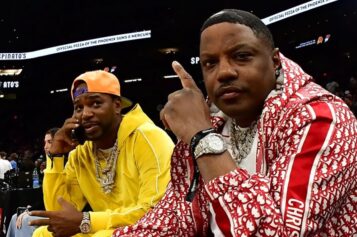(Main image photo credit: Bleacher Report)
It’s a melting pot.
Those are the words of Spokane Hoopfest’s Executive Director, Matt Santangelo. If America is considered The Melting Pot of the world, then the last weekend of June in Spokane, Washington is a prime example, when tens of thousands of people from all different races and ethnicities, multiple states and countries, descend upon the second-largest city in Washington state. They gather for Spokane Hoopfest.
THE EVENT
2015 marks the 26th edition of the world’s largest 3-on-3 street basketball tournament. What started out as two separate ideas, hoops and fundraising for the Special Olympics, has blossomed into the biggest multi-cultural event of the year in Spokane.
Looking beautiful today @SpokaneHoopfest! #Spokane#Hoopfest2015#WAstatepic.twitter.com/OAsKrQ46GE
Myk Crawford (@mykcrawford) June 27, 2015
That is no overstatement. Basketball courts covered more than 40 city blocks for the over 7,000 that participated this year. That equates to nearly 28,000 players and well over 200,000 people of all ages, all gathered together in the name of basketball. They come to play in and watch the games. They come for the entertainment factor, which includes the games, but also a dunk contest, three-point shooting contest, various kids activities and lots and lots of food.
But, if people-watching is your thing, few places compare to a Hoopfest weekend. Costumes are definitely part of the scene. Ever try playing hoops in a Darth Vader or Chewbacca costume in 100+ degree heat?
Only at @SpokaneHoopfest do you see @darthvader playing solid defense!!! pic.twitter.com/wMlBsipztX
Chris Egan King-5 TV (@ChrisEgan5) June 27, 2015
Ladies clad in bikini tops and other revealing attire. Men and boys with their size schmedium shirts. Men in their 50’s and 60’s diving for a loose ball because, well, because it’s basketball. Whatever the age, whatever the skill level, whatever the look of the fans, it’s all part of the fabric of Hoopfest.
For 26 years now, Spokane Hoopfest has been bringing together the generations. Year after year, people keep coming back to reconnect with family and friends. Young elementary kids learn the game from their parents who once played in the event. But, it’s also become a reunion of sorts.
High school rivals face off yet again or they may call each other teammates for some 3-on-3 playground-style hoops. Former pro and college players like Gonzaga’s Santangelo or Casey Calvary (Sean Rooks played year) join forces again in the Elite Divisions. This year former Louisiville Cardinal Jude Schimmel became part of a growing list of NCAA women’s hoops players who came to fuel their passion.
The numbers are staggering in and of themselves. But, there’s more to the numbers that most people don’t even give a second thought to. Perhaps that’s a good thing. But, it’s something that is worth highlighting, especially in a city like Spokane.
THE SPOKANE DEMOGRAPHIC
In 2013, the U.S. Census Bureau estimated the population of Spokane to be over 210,000. In the most recent census (2010 population was over 209,000), 86.7% was estimated to be White/Caucasian (84%, non-Hispanic or Latino). For 363 days of the year, the city is predominantly Caucasian. Walk around the downtown streets on those 363 days and you’d be hard-pressed to find someone of African-American, Hispanic or Native American descent.
That is something that takes some getting used to if you’re new to the area. Longtime Spokane-based and award-winning sports writer John Blanchette tells the story that demonstrates the culture shock.
Years ago at the Spokesman-Review we had a young African-American kid from Denver who came to work as an intern in the sports department, said Blanchette. His first Hoopfest, he walked out to the streets, looked around and said, ‘Where did all the brothers come from?’ It’s that type of reaction that many minorities who live here have when they attend their first Hoopfest.
Located on the western side of Washington, Seattle is about a four-and-a-half -hour drive from Spokane. As the state’s most populous city, Seattle, with its strong Asian influence as well as being a hoops hotbed, comes across as very culturally diverse. Walking in Seattle, you’ll see a variety of facial hues on a daily basis.
Seattle has produced many an NBA player. Jamal Crawford, Jason Terry and Nate Robinson all made their way through the rugged hoops action of Seattle. There’s a mixture of everything, culturally, on and off the courts of Seattle.
While Spokane cannot compare, diversity-wise, with Seattle on a daily basis, it has carved out its niche for one weekend a year as both a hoops hotbed and cultural melting pot. But, come Hoopfest weekend one can see that Spokane is no longer one tone. Players from many races (Caucasian, African-American, Hispanic, Native American, Asian) and cultures (American, Latinos, Slavic, Filipino, Vietnamese, Middle Eastern and more) join together and form a single mind. A mind set on basketball.
THE EARLY DAYS
There wasn’t anything else quite like Hoopfest in bringing together the races and cultures in Spokane before 1989. Bringing diversity to Spokane wasn’t a goal of organizers in the beginning. The goal was simply to play 3-on-3 basketball. But, even that was a challenge.
Blanchette, who wrote the 25th anniversary book Hoopfest last year, reflected on Hoopfest’s initial struggle: I think that first one, if I recall, was such a strange thing because they got most of their entries at the last minute. It didn’t catch on.
Downtown business owner and one of the event’s first sponsors, Debbie from Lookin’ Good Hair Salon, had a firsthand view of those early days.
It was really tough that first year, I thought, to get people involved, said Debbie. At first it was kind of hard. What is 3-on-3 basketball? and What are we going to do about this?. The people downtown where I worked, when I’d go to ask if I could put signs up in their place, it was Why would I want to do that? or What’s that all about?.
The struggle had nothing to do with the people who would be playing. The struggle was more about adjusting the downtown lifestyle which involved shutting off vehicle access by closing streets and creating courts on them instead. Once it started getting popular, Debbie says, (it was) Well, we don’t want this happening because it blocks all of our parking.
Concerns aside, downtown businesses slowly came around, realizing that it could actually be a positive for their business. And positive for the growth of Spokane’s basketball education as well, by bringing in players who perhaps weren’t as well-known as they should have been.
One such player was, whom Blanchette called, the greatest street ball player in Spokane history, Bobby Jack Sumler.
Bobby Jack and I were friends because he played on my (Spokane County rec league) team that I sponsored (and sometimes coached) for 6 or 7 years, says Debbie. Because of Bobby Jack, I had kind of won him over when he realized I did know what I was talking about with basketball, the rest of the guys said it was alright that we have a lady as a coach and sponsor. Therefore, when they talked about getting Hoopfest going, I knew a lot of basketball players. Bobby Jack was one of them that I went to and all of my team – I told the guys they all had to get their own teams (12 guys). And, they did. They all played in Hoopfest.
Being heavily involved in Hoopfest as a volunteer and sponsor, Debbie saw the racial blend early on. For Blanchette, it took a bit longer.
I kind of hoped that it would, says Blanchette. I don’t think you really saw it in that first one or maybe even those first few, so much as you did later on. Little by little you could see that it was going to cross cultural lines.
Seattle Supersonics legend, Slick Watts was at that very first Hoopfest and has seen its change and growth.
The people just love this place, said Watts. I think what it does, not only is it basketball, but it gives people an outlet to come with their kids, whether they can play or not. You see all kinds big, short, fat skinny you get them all together and for the love of the game and for the companionship. Everybody’s walking the streets. Everybody’s laughing. Everybody’s eating. Everybody’s talking. To me, there’s just so much love.
It’s a basketball kind of love.
(Photo credit: Spokanehoopfest.net)
CULTURE OF HOOPFEST
The love of basketball is what brings the people to Spokane. People from all walks of life. It also brings them face-to-face with people they might not otherwise ever encounter. With the majority of players hailing from Spokane, Hoopfest is a major introduction into players of other races and ethnicities.
Gyasi Ross is an author and speaker who is of Blackfeet (Montana) and Suquamish (Western Washington) tribal descent. He also has written for the likes of the Huffington Post and Deadspin. Ross has been playing in Hoopfest off and on for the past 10 years.
With Spokane, you’re always going to have a decent white population here. At some level, it really doesn’t matter, says Ross. If you can play ball, you can play ball.
Ross is part of the demographic that has a strong presence at Hoopfest. The Native American communities have a long tradition here.
I think part of it is that there really is a place for everyone, culturally, said Ross.
(Basketball) is a game that has managed to cross a lot of cultural divides, said Blanchette. It’s an urban game, but it’s also a real country game the old Hoosiers ethic. Around here, it’s the reservation game. It’s very much the game that Native Americans have adopted and identify with.
In Spokane, there is the namesake, Spokane Tribe. Other prominent tribes in the local area include the Colville Confederated, the Kalispel and the Coeur d’Alene. But, Hoopfest not only brings in players from these tribes but those from other regions of Washington, as well as other states, including Idaho, Oregon and Montana. One such player is JR Camel from Montana.
Camel and his team, Desert Horse Elite, won the 6’0″ & Under Men’s Elite in 2014. For as popular as basketball is with Native Americans, it seems surprising that it took so long for a team to win at the Elite level. It takes a lot to reach and win at this level, no matter where you come from. Camel and his team have, what Ross calls a formalized program. It’s what many non-Natives would identify as structured programs along the lines of AAU programs, where there is a push to extract that talent as Ross refers to it. That’s what Desert Horse has done, says Ross.
(Photo credit: KHQ.com)
BASKETBALL VISION
Winning is also what Desert Horse has done again this year. Repeating as Hoopfest Elite champs is no easy task. Especially on a weekend with temperatures in Spokane soaring above the century mark. It would have been easy for tempers to flare from anyone on the courts this weekend. But, it doesn’t happen often. Clearly, Hoopfest is about the game.
Spokane is at an interesting crossroads, said Blanchette. We’re not necessarily urban, although there’s a growing African-American population here. We’re pretty country. We’re quasi-urban. We’re very close to reservations. We’re close to the Hispanic community, especially from Central Washington, that has also adopted the game well. There’s some real grass-roots basketball within a 2-3 hour drive to this place that has kind of stocked this Hoopfest.
Racism is a learned trait. It’s taught and handed down from generation to generation almost like a precious heirloom. Stocking Hoopfest with players numbering in the thousands, who are so racially and culturally diverse would seem to be a breeding ground for chaos.
But, that doesn’t seem to be the case at Hoopfest.
For the most part, the majority, the younger people don’t see that, says early volunteer Debbie. If you have a problem, (the players) they just want to play. The majority of people could care less who they were going to play.
From the Elite-level courts down to the elementary-age youth, it’s not uncommon to see players from opposing teams pick each other up after a fall or a hand slap after a good play. There’s a camaraderie and a respect that is the essence of Spokane Hoopfest.
UNDERSTANDING THROUGH PLAY
As the post-Hoopfest sun rose on Monday morning in Spokane, the courts will be gone and the streets of downtown Spokane opened for drivers again. Out-of-town players and visitors were heading home, if they’re weren’t there already. Spokane returned to normal. Or, a new normal.
Although not always easily discernible, Spokane changes after each Hoopfest. It also changes the people that were part of the event too. Says Debbie, I think it has opened a few people’s eyes in Spokane that maybe had never been around any other race. To walk through downtown Spokane on Hoopfest weekend, especially on Saturday, I mean where do you go to see that cross-racial grouping?
The answer is there is nowhere else and at no other time in Spokane.
I hope it fosters a little more understanding, says Blanchette.
An understanding for both Spokane residents and visitors that our racial differences don’t have to prohibit dialogue. Basketball, through the eyes and streets of Hoopfest, is a language that needs no translation. Anyone can speak it.
Anyone can play it.
For Part 2 of our feature on the Spokane Hoopfest, read here.





